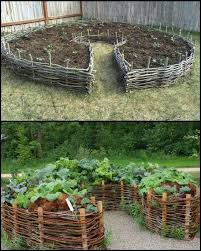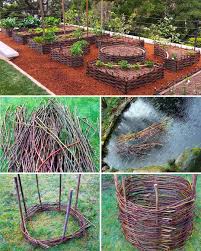Wattle weaving, a centuries-old craft, offers an eco-friendly way to build beautiful, functional garden structures. By weaving flexible branches like willow or hazel, you can create a durable, rustic raised garden bed that enhances your backyard’s aesthetic appeal. Here’s how to build one step by step.
Materials You’ll Need
- Flexible branches or twigs (willow or hazel preferred for their flexibility and strength)
- Sturdy stakes (2 feet longer than the bed’s desired height)
- Hammer or mallet
- Pruning shears
- Garden gloves
- Measuring tape
- Soil and compost mix
Step-by-Step Instructions
1. Plan Your Garden Bed
- Decide on the size and location based on sunlight needs for your plants.
- Sketch a rough design, including dimensions and shape.
2. Prepare the Site
- Clear the area of weeds and debris.
- Level the ground to ensure the bed sits evenly.
- Mark the bed’s outline with string or chalk for precision.
3. Gather Your Materials
- Collect long, flexible branches or twigs. Fresh, green branches are easier to weave.
- Cut them to uniform lengths, keeping in mind the height and circumference of your bed.
4. Install the Stakes
- Cut stakes to your desired height (bed height + 2 feet).
- Drive the stakes into the ground along the marked outline, spacing them evenly, and leaving about 2 feet above ground.

5. Weave the Wattle
- Begin weaving at a corner. Intertwine branches horizontally between the stakes, alternating sides for strength.
- Gently bend branches as needed and keep the weave tight. Trim excess branch lengths with pruning shears.
6. Build the Walls
- Continue layering woven branches until your bed reaches the desired height.
- Ensure layers are tightly interlocked to maintain stability.
7. Secure the Top
- Tuck the ends of the final woven layer securely.
- For a polished look, add a rigid border or finishing trim along the top edge.
8. Fill the Bed
- Mix garden soil with compost to create a nutrient-rich planting medium.
- Fill the wattle bed with this soil-compost mixture.
9. Plant Your Garden
- Select plants suitable for the bed’s size and sunlight availability.
- Plant seeds or seedlings according to their specific care requirements.
10. Maintain Your Bed
- Water your plants regularly, keeping the soil moist but not saturated.
- Add mulch to retain moisture and suppress weeds.
- Inspect the wattle for loose branches and prune as needed to maintain its structure.
Expert Tips for Success
- Use freshly cut, green wood for easier weaving and longer-lasting results.
- Branch flexibility is essential for smooth, tight weaves.
- Regular upkeep of the wattle ensures durability and aesthetic appeal.
Creating a wattle raised garden bed is a rewarding DIY project that blends functionality with sustainability. This timeless technique not only recycles natural materials but also adds rustic charm to your outdoor space. With proper care, your wattle bed will provide a thriving garden for years to come.
Happy gardening!
